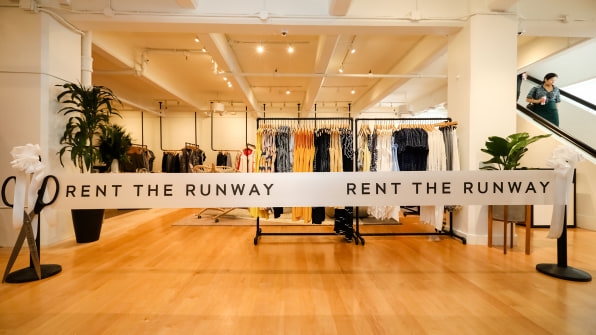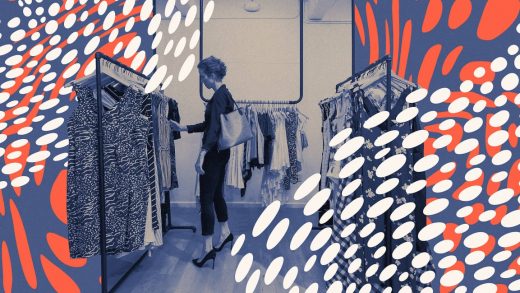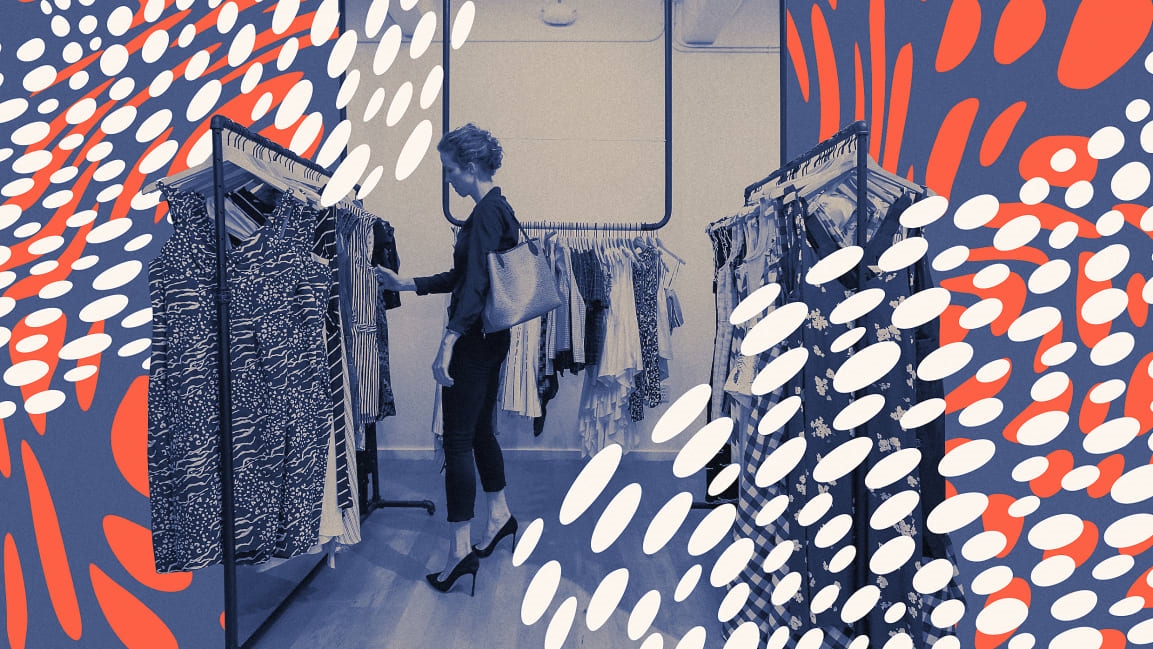Forget renting the runway. Now you can own it
As the COVID vaccine rolls out and Americans prepare for a summer of reunions, dates, and parties, one question remains: What to wear in this new world?
Thousands of people, ready to leave their sweats behind, may find that their outlook or body has changed and want an entirely new wardrobe. Fashion company Rent The Runway, which struggled during the pandemic when reasons to dress up were few and far between (Coresight Research estimated that the size of the U.S. rental apparel market declined to $1.1 billion in 2020 compared to $1.3 billion the year before) says it has seen thousands of women return to the platform to reserve flashy designer clothing (think cutouts, minidresses, and bright patterns) for occasions as big as weddings and as small as brunch with friends. Now, Rent The Runway is making another offer to customers: They can own the runway. The company is making all of its clothes available for resale to subscribers and casual shoppers alike.
Since 2016, existing members have been able to purchase items that they have rented and want to keep. The company has developed a sophisticated algorithm to price items based on demand, material, durability, and ROI already generated from the item. This can lead to some good deals—a pair of Re/Done cigarette jeans I have been coveting, which ordinarily retails for $265, is available to purchase on the site for $148.32—and some less good deals (some relatively new items might only be discounted by 10%). Now, everyone, regardless of membership status, can use the service to buy second-hand clothes.
The experience of browsing through Rent the Runway can sometimes feel like a trawl through Filene’s Basement thanks to an abundance of statement pieces designed to appeal to different tastes (there are a lot of patterns). But the platform’s resale offerings differ from the limited selection in discount stores like Century 21 and sites like The RealReal in an important way: the curated selection of clothing is available in full size runs. The company may eventually use its dynamic pricing technology to help brands host rental and resale platforms on their own sites.
With the exceptions of travel and hospitality, few industries have been more impacted than fashion during the pandemic. In March 2020 as COVID spread, the company—which was originally founded as an evening-wear rental business before expanding to become a “closet in the cloud” for subscribers—saw its revenue decrease dramatically. Prior to the onset of COVID, Rent The Runway had a reported valuation of $1 billion and was rumored to be marching toward an IPO. As it became apparent that the pandemic would last longer than a few weeks, cofounder and CEO Jennifer Hyman laid off 15% of the staff and furloughed another 35% in March of last year (all of the furloughed workers have since been brought back). Rent The Runway also closed physical retail stores in New York, Chicago, DC, and San Francisco. To weather the pandemic, the company raised $100 million in capital in a combination of debt and equity– the raise valued the company at around $800 million, lower than its previous unicorn status.

[Photo: Kelly Sullivan/Getty Images/Rent the Runway]
Second-hand retail has become increasingly popular with resale platform Poshmark going public in January and luxury consignment store The RealReal going public in 2019. Hyman believes that the market is big enough for every player. She says that because its inventory is highly curated and comes in full size runs, shopping on Rent The Runway doesn’t compare to The RealReal where customers may have to scroll through cast-off items people want to get rid of. “The runway feels more like a luxury site than it feels like a treasure hunt,” she says.
Ultimately, the resale expansion broadens the company’s customer base by bringing more people onto the platform. “It expands our funnel. We’ve had incredible success over the years getting our customers who have rented from a special event to convert into being subscribers,” she says, adding that clothing rental will still be the company’s primary line of business. “Rental makes up about 75% of our business, and I don’t expect that to change,” Hyman says. “This helps us monetize inventory [because] we’re able to dynamically price it for sale at any point in time to kind of capture more revenue today than we would have if it continues to rent over an estimated period of time.”
Some clothing companies, like La Ligne, have also found that developing a second-hand market on their site can encourage customers to spend more with the company. La Ligne partnered with Recurate to launch Re-Ligne, which lets users sell their older sweaters for store credit toward newer ones. “It’s a great way to be more sustainable, and keep customers shopping with us,” cofounder Meredith Melling says.
Elizabeth Cline, author of The Conscious Closet says that more research needs to be done before Rent The Runway’s circular economy for clothes can be called environmentally friendly. “A lot of what is said about fashion rental and sustainability is based on assumptions and not actually on scientific studies, lifecycle assessments, and good data.” Cline wants more studies done on whether customers who rent clothes purchase fewer items, for example. Overall though, she sees the resale expansion as a boon: “I think expanding resale is a good thing—incorporating a resale program is helping in some small part, not replicate like a fast fashion cycle. They’re making sure that those clothes get worn again.”
Rent the Runway has commitments in place to mitigate its inventory’s impact on the environment– the company makes clothing that is no longer in rentable condition available in sample sales and on second-hand retailer ThredUp through its Revive program. RTR also donates clothes to nonprofit organizations including Dress for Success and FabScrap.
Hyman says that the company has not had to make any meaningful changes to its inventory orders to fuel the expansion of resale. The company hired Brian Donato as their Chief Supply Chain Officer in February 2020. Donato, who previously worked at Amazon in various operations roles has worked with board member Mike Roth, Amazon’s former Vice President of Supply Chain and Fulfillment, to optimize the company’s warehouses located in Seacaucus, New Jersey and Arlington, Texas and make them more efficient and able keep up with increased demand that they expect with the post-covid uptick—”we can now fulfill four times what our maximum subscriber rate was in 2019,” Hyman says.
Last week it was announced that GOOP entrepreneur Gwyneth Paltrow had joined the company’s board. She also received her first Rent The Runway shipment last week. Paltrow told us that, like yoga, she has pioneered the clothing rental trend: “I’ve been renting the runway in my own way for years, and I always thought it was a genius business model in terms of choice and sustainability.” Like Rent The Runway, Paltrow’s GOOP has suffered at the hands of COVID– last week the company announced plans to close its London store. Hyman says that Paltrow’s ability to create content around her brand makes her an attractive partner for the company– “she’s married commerce and content in a really organic way.”
Though many customers stopped their subscriptions during COVID.– and the company announced that it would phase out its unlimited rental option in September– they actually put their subscriptions on hold rather than canceling entirely, ready to resume renting as cities opened up. Now, the company says that active subscribers are up 97% from their COVID low in May 2020 as women are turning everyday events—brunch with friends, birthday parties—into an excuse to dress up. “People want bright, colorful, optimistic, and they can’t wait,” Hyman says. “They were so excited they were ordering mini dresses in March even though the average temperature in New York was 39 degrees.”
(18)



